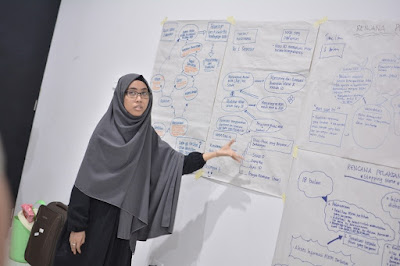 |
| Stevlin receives an ultrasound reading at a community health centre in Sorong, West Papua © Cory Rogers / UNICEF / 2017 |
Soon, fuzzy thumps flood the room, and she breaks into a grin: It's not every day one hears their child’s heartbeat for the first time.
Stevlin’s come to the Malawei community health centre in Sorong, West Papua Province, for an antenatal check-up.
“I have to make sure my pregnancy goes well so that my baby is born healthy," she says, furrowing her brow. Stevlin lost a child to health complications in the early 2000’s, and is determined to do all she can to ensure her new baby is healthy as can be. That means eating well, exercising, sleeping enough, and testing for diseases -- especially HIV.
“West Papua has an HIV risk 15 times the national average, so testing is an absolute must for pregnant mothers here,” says Beth Nurlely, a UNICEF Indonesia Health Officer based in the province.
Though there is a 1 in 3 chance of passing HIV on to a child absent treatment, across Indonesia just 14 per cent of mothers get tested for the virus.
“With antiretroviral therapy, the rate of transmission is reduced to near zero,” Nurlely adds. “We need to find creative ways to increase testing.”
Papua on the frontlines
Sorong, a gritty port town in the West Papua Province of Papua*, is one of four cities (Surabaya in East Java Province, West Jakarta in DKI Jakarta and Bandung in West Java Province) where UNICEF and the World Health Organization (WHO) have been testing new approaches to preventing mother-to-child transmission of HIV (PMTCT).
In Papua, the risk of transmission has spread beyond vulnerable groups like sex workers into the general population, putting mothers like Stevlin and her baby at risk. Indeed, without marked increases in access to testing and treatment nationwide, experts say the number of children infected with HIV will double over the next decade.
 |
| A pregnant mother and her young daughter wait in line to be seen at a village health post in Sorong, West Papua © Cory Rogers / UNICEF / 2017 |
Despite the danger, Stevlin says it wasn’t until 2014 that she received her first test, by which time she’d already given birth to three children.
“To be honest, I don’t really know what HIV is, but I do know I need [to test for it],” she says, as a midwife pricks her finger for blood.
“I get nervous now. l want to know my status right away.”
Empowering bidan
That Stevlin’s rapid HIV test was administered by one of the health centre’s bidan (midwives) is a significant achievement.
“Historically, only lab specialists have been permitted to do tests,” Nurlely says. “But there is a shortage of these trained professionals in West Papua. This has become a big bottleneck on testing.”
Persuading local governments to train midwives and allow them to carry out rapid testing is a major goal of the UNICEF pilots nationwide. In Sorong, the breakthrough came in September 2014, when the local government agreed such a reform would boost testing and protect mothers and babies.
 |
| A midwife at Malawei initiates Stevlin's HIV test © Cory Rogers / UNICEF / 2017 |
“We succeeded in convincing officials that the number of lab specialists was insufficient to cover testing needs, and so midwives were freed to do this important work,” Nurlely says.
Three years since that reform, testing has increased to 60 per cent among pregnant women in Sorong – some five times the national average.
Ending ‘informed consent’
Training midwives to treat HIV like any other blood test has been another key to reducing PMTCT, says Roys Fetty Mulalinda, the head midwife at Malawei.
Before the UNICEF intervention, pregnant women were required to sign a consent form to take an HIV test. This sounds good in theory, but consenting to a test in this way implies negative associations and, says Nurlely, reflects the stigma against the disease, which many view as a kind of curse.
Now, thanks to the advocacy of local government, Roys Fetty says the consent forms are gone and the test has become commonplace. Now instead, women have to sign a waiver to opt out of the HIV test acknowledging their understanding of the risks to themselves and to their babies.
“If a pregnant woman comes here, the HIV test is basically automatic,” Roys Fetty says. “The only reason they wouldn’t get tested [on our end] is if there was a stock-out.”
 |
| Stevlin smiles after learning she is HIV negative © Cory Rogers / UNICEF / 2017 |
A new grant from the Global Fund will allow UNICEF and the Government of Indonesia to expand the pilot to 28 districts next year, which will help build nationally on the successes seen in Sorong.
That four out of 10 pregnant women still decline HIV tests, however, suggests there’s room to do even more.
“If we want to reach all pregnant mothers, we need a provincial-level law that applies more broadly,” Nurlely says.
Such a regulation in the province has yet to be passed, but signs are hopeful: local-level PMTCT reforms are already underway in 10 of Papua’s 13 districts. Hopefully, it won’t be long until all pregnant mothers have access to this vital test.
*Papua is the island on Indonesia’s eastern frontier formed by West Papua and Papua, the country’s two poorest provinces.
































